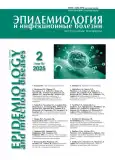Untimely vaccination – missed opportunities for protection against childhood infections at an early age
- Authors: Minaeva V.A.1,2, Golubkova A.A.1,3
-
Affiliations:
- Russian Medical Academy of Continuing Professional Education, Ministry of Health of the Russia
- Children’s City Polyclinic № 86
- Central Research Institute of Epidemiology, Russian Federal Service for Supervision of Consumer Rights Protection and Human Well-Being
- Issue: Vol 15, No 2 (2025)
- Pages: 44-49
- Section: Original Investigations
- Published: 09.07.2025
- URL: https://journals.eco-vector.com/2226-6976/article/view/686698
- DOI: https://doi.org/10.18565/epidem.2025.15.2.44-49
- ID: 686698
Cite item
Abstract
In most countries with vaccination problems, information on the timeliness and completeness of vaccination coverage of children is monitored only at certain age periods, namely at 12 or 24 months, which does not provide an idea of how timely, i.e. at the age determined by the National Immunization Schedule (NIS), young children were vaccinated against specific infections.
Objective. Determination of the impact of untimely vaccination on the schedule of subsequent vaccinations regulated by the NIS.
Materials and methods. The study was conducted in 2024 at a large Moscow pediatric outpatient clinic and included an analysis of electronic medical records, including form 063/u, of children registered with specialist doctors (n = 4783). In the cohort up to 6 years (inclusive) (n = 472), an analysis of vaccination against 7 infections (tuberculosis, hepatitis B, diphtheria, whooping cough, measles, rubella and mumps) was carried out and an assessment of the timeliness of the start and completion of the relevant vaccination complexes was carried out.
Results. In children with health problems, a significant delay in the timing of vaccinations in the age periods regulated by the NIS was found. A positive statistically significant correlation was found between the start of vaccinations according to the NIS and the age of subsequent vaccinations, which confirms that a delay in the first vaccinations has a complex effect on the entire system of protection against infections, and not just one of them.
Conclusion. Untimely vaccination determines the lack of protection against vaccine-preventable infections in children at the age periods most vulnerable to these infections. Monitoring the timeliness of the start of vaccination should become one of the indicators of the quality of the work of the district pediatric service.
Full Text
About the authors
Victoria A. Minaeva
Russian Medical Academy of Continuing Professional Education, Ministry of Health of the Russia; Children’s City Polyclinic № 86
Author for correspondence.
Email: minaevava@zdrav.mos.ru
ORCID iD: 0000-0002-2434-6706
Postgraduate Student; Epidemiologist
Russian Federation, Moscow; MoscowAlla A. Golubkova
Russian Medical Academy of Continuing Professional Education, Ministry of Health of the Russia; Central Research Institute of Epidemiology, Russian Federal Service for Supervision of Consumer Rights Protection and Human Well-Being
Email: allagolubkova@yandex.ru
ORCID iD: 0000-0003-4812-2165
МD, Professor, Department of Hospital Epidemiology, Medical Parasitology and Tropical Diseases; Leading Researcher
Russian Federation, Moscow; MoscowReferences
- Raguindin P.F., Morales-Dizon M., Aldaba J., Mangulabnan L.P., Reyes R.P., Batmunkh N. et al. Timeliness of childhood vaccinations in the Philippines. J. Public Health Policy 2021; 42(1): 53–70. doi: 10.1057/s41271-020-00255-w
- Kiely M., Boulianne N., Talbot D., Ouakki M., Guay M., Landry M. et al. Impact of vaccine delays at the 2-, 4-, 6- and 12-month visits on incomplete vaccination status by 24 months of age in Quebec, Canada. BMC Public Health 2018; 18(1): 1364. doi: 10.1186/s12889-018-6235-6
- Loy S.L., Cheung Y.B., Chan J.K.Y., Soh S.E., Godfrey K.M., Tan K.H. et al. Timeliness of childhood vaccination coverage: the growing up in Singapore towards healthy outcomes study. Prev. Sci. 2020; 21(3): 283–292. doi: 10.1007/s11121-019-01078-2
- Mekonnen Z.A., Gelaye K.A., Were M.C., Tilahun B. et al. Timely completion of vaccination and its determinants among children in northwest, Ethiopia: a multilevel analysis. BMC Public Health 2020; 20(1): 908. doi: 10.1186/s12889-020-08935-8
- Минаева В.А., Голубкова А.А. Вакцинация против туберкулеза детей раннего возраста во время пандемии COVID-19: современные практики. Эпидемиология и инфекционные болезни 2022; 27(6): 333–340. doi: 10.17816/EID111867. Minaeva V.A., Golubkova A.A. [Vaccination against tuberculosis in infants during the COVID-19 pandemic: current practices]. Epidemiology and Infectious Diseases 2022; 27(6): 333–340. (In Russ.). doi: 10.17816/EID111867
- Siddiqua A., Kabir M.A., Chowdhury M.E.H. A framework to identify the children who missed basic vaccines in developing countries. Surveillance, prevention, and control of infectious diseases: an AI perspective. Cham: Springer Nature Switzerland 2024; 115–138. doi: 10.1007/978-3-031-59967-5_6
- Currie G. E., McLeod C., Waddington C., Snelling T.L. SMS-based interventions for improving child and adolescent vaccine coverage and timeliness: a systematic review. BMC Public Health 2024; 24(1): 1753. doi: 10.1186/s12889-024-18900-4
- Старшинин А.В., Камынина Н.Н., Нечаев О.И. Информационные технологии в вакцинации: анализ зарубежного и российского опыта экспертный обзор. М.: НИИОЗММ ДЗМ, 2023. Starshinin A.V., Kamynina N.N., Nechaev O.I. Information technologies in vaccination: analysis of foreign and Russian experience: expert review. Moscow: Research Institute of Healthcare Organization and Medical Management оf Moscow City Health Department, 2023 (In Russ.).
Supplementary files






